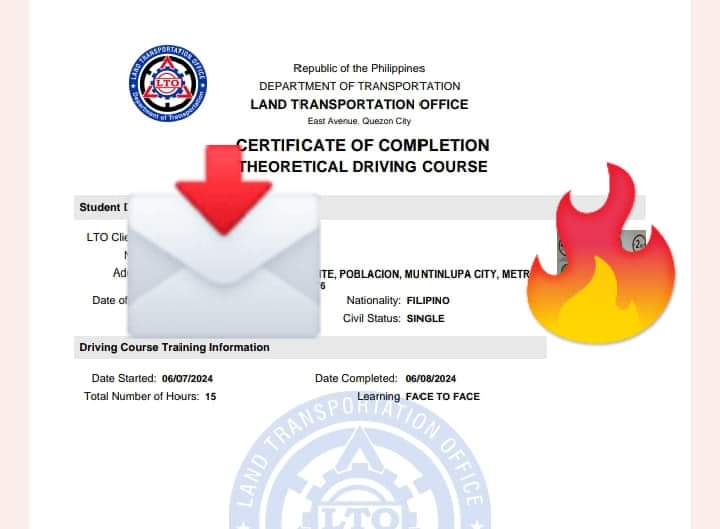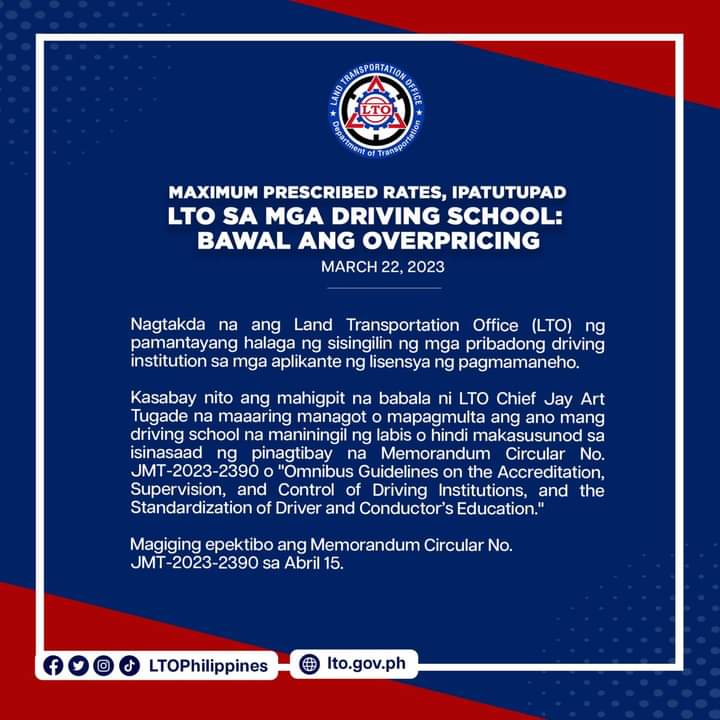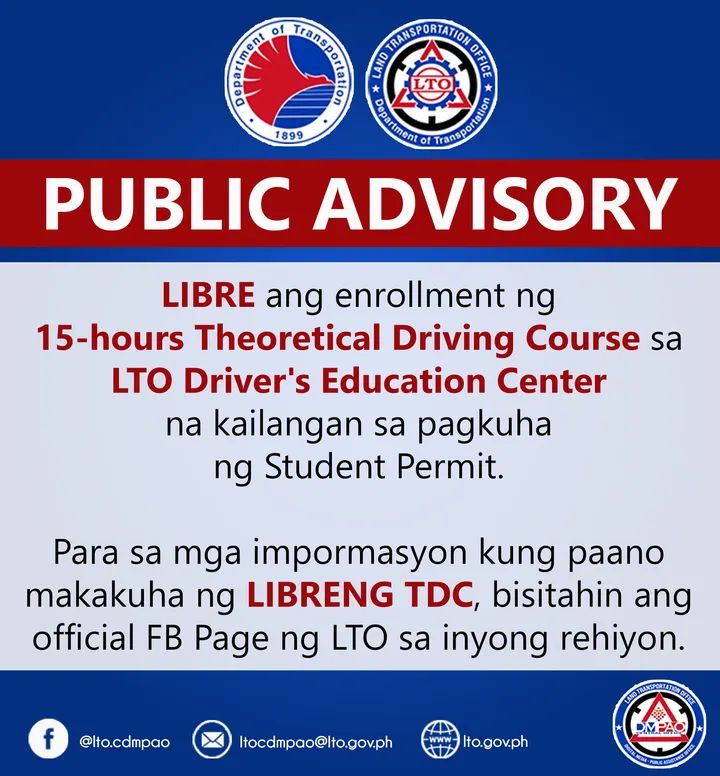The Land Transportation Office (LTO) Theoretical Driving Course (TDC) is a program that teaches people the basics of driving and road safety. It’s important for anyone who wants to get a Student-Driver’s Permit in the Philippines. The LTO created this mandatory 15-hour course to ensure new drivers know the essential driving knowledge and skills, including the traffic rules, vehicle maintenance, and safe driving practices.
The TDC is designed to educate new drivers about the basics of driving and road safety. Having said that, anyone who wants to apply for a Student-Driver’s Permit, including both the teenagers who are just starting to drive and the adults who want to learn how to drive are required to take this course so they understand and learn the rules and responsibilities of driving. By completing the TDC, drivers become more knowledgeable and confident on the road, leading to fewer accidents and safer driving conditions for everyone. Consequently, if you don’t take the TDC, not only will you not be able to get a Student-Driver’s Permit, but you also can’t legally drive or practice driving on public roads.
What is LTO TDC?
The LTO Theoretical Driving Course (TDC) is a mandatory 15-hour class designed by the LTO for those who want to get a Student-Driver’s Permit in the Philippines. This course covers essential topics such as traffic rules, vehicle parts, and safe driving practices to ensure new drivers are well-prepared and knowledgeable. Completing the TDC is the first step to becoming a responsible driver and is required by law before taking any practical driving lessons.
During the TDC, students learn about the history and role of the LTO, traffic signs, and road regulations. They also study vehicle maintenance, defensive driving techniques, and how to handle emergencies on the road. Following the classroom sessions conducted by accredited driving institutions or online providers, is an exam to assess the applicant’s understanding of the material at the end of the course. Students are required to pass this exam to receive a certificate, which they need to apply for their Student-Driver’s Permit.

Understanding the LTO TDC Curriculum
The TDC curriculum is structured into three sessions, each lasting five hours. Topics covered include the role of the LTO, traffic signs and regulations, vehicle components and maintenance, and emergency handling procedures. The course emphasizes road safety, proper driving behavior, and compliance with laws governing transportation.
The topics are scheduled as follows:
First Session (5 hours)
1. Introduction to Driving (1 hour)
- General Information and Core Application of Land Transportation
- Driver’s Licensing System
- Motor Vehicle Registration System
- Law Enforcement and Ticketing System
- Relationship with other Agencies
- Land Transportation Franchising and Regulatory Board (LTFRB)
- Philippine National Police Highway Patrol Group (PNP-HPG)
- Local Government Units (LGUs)
- Department of Public Works and Highways (DPWH)
2. Road and Traffic Rules (1.5 hours)
- Traffic Signs, Signals, and Pavement Markings
- Rules on Turning, Overtaking, and Right of Way
- Rules on Parking and other Provisions
- Expressway Rules and Regulations
3. Pre-Driving Orientation and Motor Vehicle Basic Parts, Functions, and Operations (1.5 hours)
- Essential Components of Motor Vehicle
- Basic Functions of Identified Parts and Other Safety Features of Motor Vehicle
- Walk Around Check and Pre-Engine Starting Routine
- Applicable Laws, Rules, and Regulations
- Driving Procedures
- Tips on Stopping, Parking, Turning, and Changing Lanes
- Post-Driving Routine
4. Written Examination (30 minutes)
Second Session (5 hours)
1. Review of First Session Topics (30 minutes)
2. Defensive Driving and Motor Vehicle Maintenance (3 hours)
- Attitude and Behavior
- Road Safety, Sharing, Courtesy, and Discipline
- Understanding and Avoiding Road Rage and Stress Management
- Causes and Prevention of Road Crashes and Breakdowns
- BLOWBAGETS
- Human Factors (Fatigue, Distracted Driving, etc.)
- Lack of Communication and Timely Information
- Lack of Motor Vehicle Basic Knowledge
- Improper Parking
- Motor Vehicle Factor Roadworthiness (Proactive and Reactive Maintenance)
- Engineering/Infrastructure Factors (Road Designs, Traffic Signs/Signals, etc.)
3. Handling Emergencies and Breakdowns (1.5 hours)
- Emergency Situations
- Road Crashes
- First Aid
4. Written Examination (30 minutes)
Third Session (5 hours)
1. Review of Second Session Topics (30 minutes)
2. Driver’s Duties and Responsibilities (1.5 hours)
- Physical and Mental Wellness
- Passengers and Cargo Handling
- Duties and Rights of Drivers when Apprehended
- Proper Uniform Attire (for hire)
3. Land Transportation Related Special Laws (1.5 hours)
- R.A. No. 4136 (Land Transportation and Traffic Code)
- R.A. No. 8749 (Philippine Clean Air Act of 1999)
- R.A. No. 8750 (Seat Belt Use Act of 1999)
- R.A. No. 8794 (Motor Vehicle User’s Charge Act)
- R.A. No. 10054 (Motorcycle Helmet Act of 2009)
- R.A. No. 10586 (Anti-Drunk and Drugged Driving Act of 2013)
- R.A. No. 10666 (Children’s Safety on Motorcycle Act of 2015)
- R.A. No. 10913 (Anti-Distracted Driving Act)
- R.A. No. 10916 (Road Speed Limiter Act of 2016)
- R.A. No. 11229 (Child Safety on Motor Vehicles Act)
- R.A. No. 11235 (Motorcycle Crime Prevention Act)
- Traffic Administrative Rules, Violations, Fines, and Penalties
- Gender and Development (GAD) and Active Transport and Light Mobility Vehicle
- LTO Road Safety Advocacy Videos
4. Written Examination and Review (1.5 hours)
- Review of Topics from First to Third Session
- Question and Answer Session
Course Delivery
Students can choose between face-to-face classes at LTO-accredited centers or online courses offered by accredited providers. Both options provide comprehensive education on driving safety and regulations. The choice of delivery method allows flexibility for students to learn in the environment that suits them best.
Classroom Instruction
The LTO TDC consists of 15 hours of classroom instruction, divided into three sessions of five hours each. These sessions cover topics like traffic rules, vehicle maintenance, and defensive driving. Accredited driving schools or LTO centers conduct these sessions to ensure uniform quality and delivery.
Online Instruction
The TDC can also be taken online through LTO-accredited providers. Online courses follow the same curriculum and require interactive participation. After completing the online sessions, students must pass an exam to receive their TDC Certificate.
Exam and Certification
After completing the classroom or online sessions, students take a final exam consisting of 120 questions. To pass, they need to score at least 80%. Upon passing, students receive a TDC Certificate of Completion, necessary for obtaining a Student-Driver’s Permit.
How to Enroll for TDC
Enrolling in the Theoretical Driving Course (TDC) is a straightforward process essential for obtaining a driver’s license in the Philippines. Knowing the necessary requirements and procedures ensures a smooth enrollment experience. Here is a step-by-step guide to help you get started.
Requirements
- Valid ID (e.g., Passport, School ID, or Government-issued ID)
- Birth Certificate (Original or PSA copy)
- Recent Photo (Passport size)
- Proof of Address (Utility bill or Barangay clearance)
- Application Form (Available at LTO offices or driving schools)
Procedures
Step 1. Choose an Accredited Driving School
Select a school that is recognized by the LTO to ensure compliance with the new guidelines.
Step 2. Submit Requirements
Provide the necessary documents listed above to the driving school.
Step 3. Register and Pay Fees
Complete the registration form and pay the TDC fee of up to PHP1,000.

Step 4. Attend Classes
Participate in the 15-hour theoretical driving course, spread over two days.
Step 5. Biometric Registration
Register your biometrics before and after each session for attendance tracking.
Step 6. Take the Final Exam
Pass the final written exam at the end of the course.
Step 7. Receive Certificate of Course Completion
Obtain your certificate, which is electronically transmitted to the LTO system.
By following these steps, you can successfully enroll in and complete the TDC, bringing you closer to obtaining your driver’s license.
Fees

The LTO has set the maximum fee for the TDC at PHP1,000. This new rate is designed to make driving education more affordable in response to the previous complaints about high costs in driving schools. All accredited driving schools must adhere to this fee cap to prevent overcharging or they will face strict penalties. For TDC taken at LTO Drivers Education Centers (DECs) or at the various LTO offices, the course is available free of charge.

Duration
The LTO has also shortened the duration of the TDC. Now, applicants can complete the mandatory 15-hour course within two days. Previously, the TDC could take up to a month to complete, with sessions spread out over several days. The updated schedule requires three to seven hours on the first day and the remaining hours on the second day. This new structure streamlines the process, making it faster and more convenient for applicants to complete their training efficiently.
TDC Validity
Applicants must register with an LTO-accredited driving school, provide necessary documentation including birth certificates and valid IDs, and attend all scheduled sessions punctually. The TDC Certificate is valid for one year and serves as a prerequisite for the Practical Driving Course required for obtaining a non-professional driver’s license.
Video: Application and Requirements for Getting a TDC Certificate
To better understand the application procedures and requirements to complete the mandatory LTO Theoretical Driving Course (TDC) and secure a TDC Certificate, watch this informative video from John Ryan Magalona:
Summary
In summary, the LTO TDC is a vital step for anyone aspiring to drive legally in the Philippines. It ensures that new drivers have the necessary knowledge and skills to operate a vehicle safely, contributing to overall road safety and responsible driving practices.